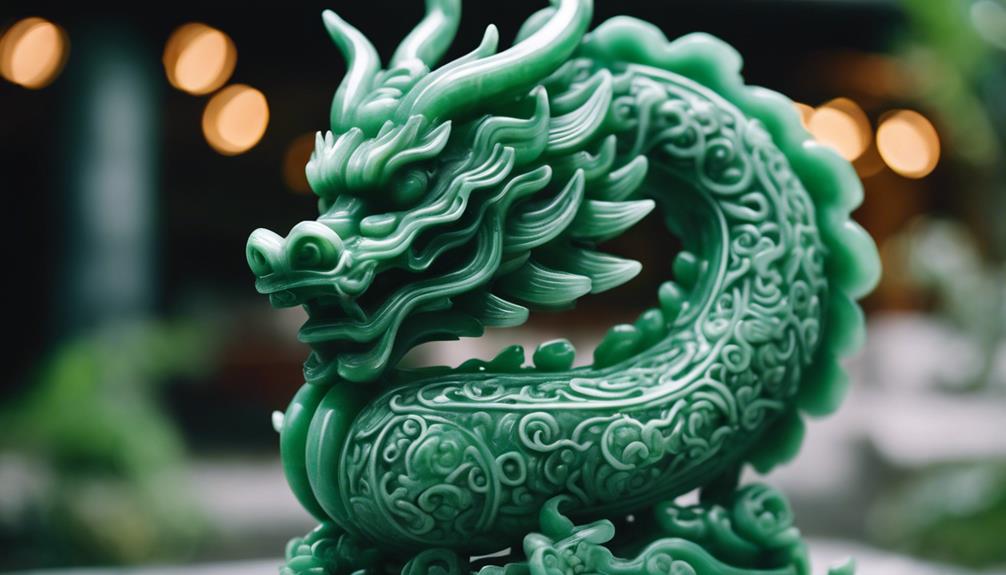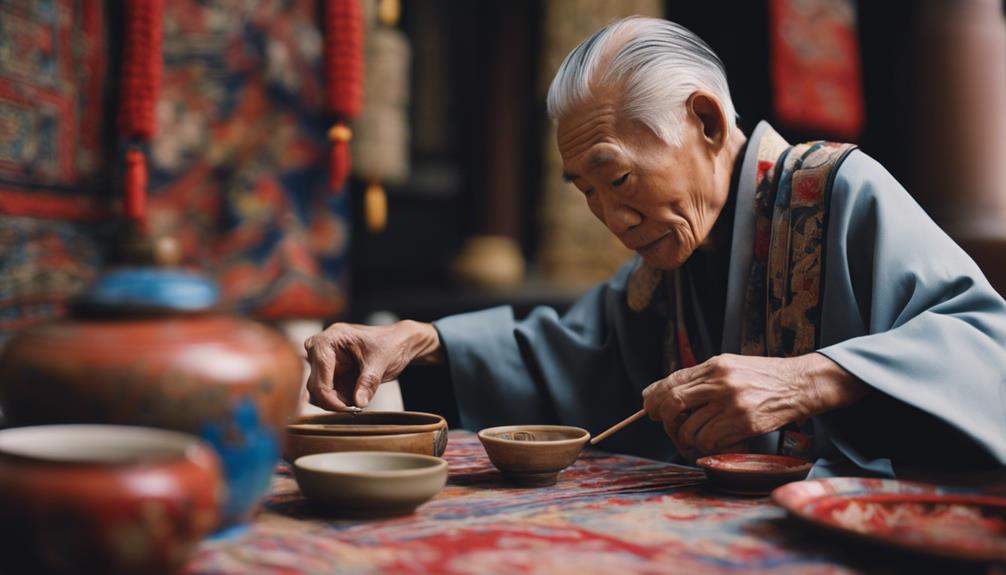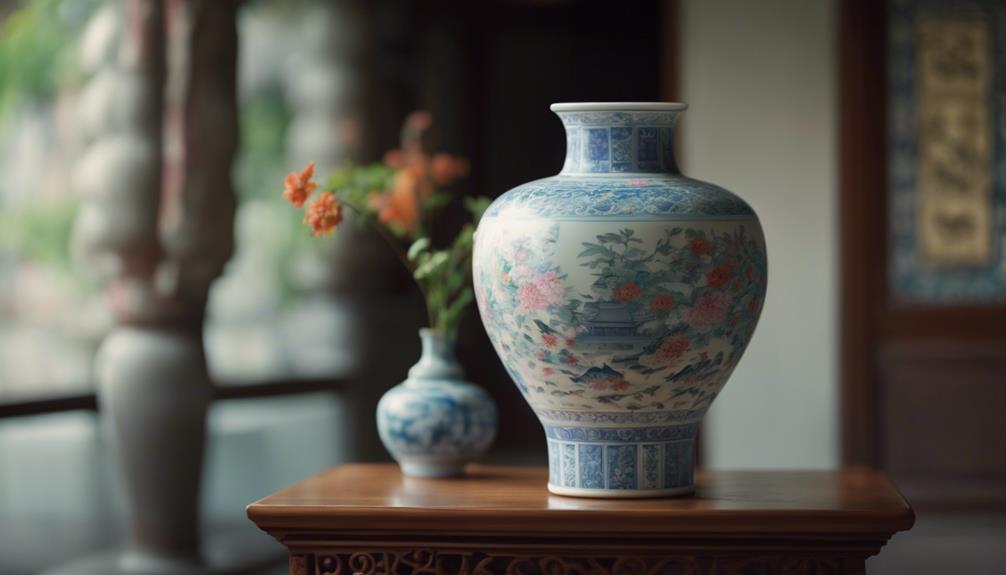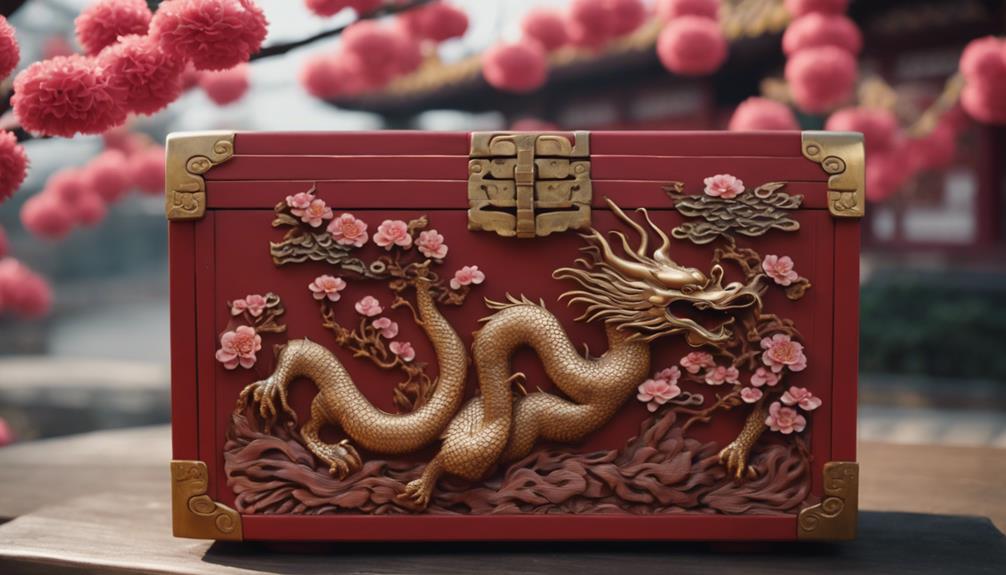Taiwan
The Treasures of Taiwan Revealed
Get ready to uncover the hidden gems of Taiwan's cultural heritage, starting with a journey through the National Palace Museum's captivating treasures.

Begin a journey through Taiwan's cultural treasures at the National Palace Museum, where centuries of Chinese history unfold before you. Explore artifacts embodying traditional Chinese culture and intricate craftsmanship, offering a glimpse into the country's rich heritage. Discover the stories behind jade sculptures, revealing cultural richness and historical significance. Unearth the symbolism in ancient cauldrons, showcasing artistic expression dating back to the 8th century BC. Taiwanese treasures like the Jadeite Cabbage and Meat-shaped Stone embody traditional meanings, providing valuable insights into the island's identity. Immerse yourself in the enchanting museum experience, delving deeper into the vibrant cultural tapestry of Taiwan.
Key Takeaways
- National Palace Museum in Taiwan holds invaluable Chinese artifacts.
- Treasures showcase centuries-old traditions and craftsmanship.
- Explore artifacts like the Jadeite Cabbage and Meat-shaped Stone.
- Gain insights into Chinese culture, history, and artistry.
- Museum offers a captivating experience of Taiwan's cultural heritage.
Cultural Significance of Taiwan's Treasures
The cultural significance of Taiwan's treasures lies in their role as guardians of Chinese history and heritage. Housed in the National Palace Museum, these invaluable artifacts symbolize the essence of traditional Chinese culture, serving as a confirmation of the country's rich cultural heritage. The collection, which includes renowned pieces like the Jadeite Cabbage and Meat-shaped Stone, not only showcases exquisite craftsmanship but also holds immense historical importance.
Separated from the treasures in Beijing's Palace Museum, Taiwan's collection sheds light on the divided history of China, influenced by political circumstances. With over 700,000 pieces of Chinese art, ranging from ceramics to paintings spanning thousands of years, the National Palace Museum in Taiwan stands as a beacon for preserving traditional Chinese culture.
These treasures not only enrich Taiwan's cultural landscape but also play a crucial role in promoting global appreciation for Chinese art and history, making them essential pillars of cultural preservation and education.
Historical Insights at National Palace Museum

Explore the historical revelations awaiting you at the National Palace Museum in Taiwan. This renowned institution houses invaluable imperial relics that were safeguarded during turbulent historical periods. The museum's collection not only showcases significant Chinese art pieces but also acts as a symbol of historical preservation efforts. Treasures like the Jadeite Cabbage and Meat-shaped Stone stand as affirmations to the museum's cultural significance and dedication to conserving China's rich heritage.
Within the walls of the National Palace Museum, visitors can immerse themselves in a diverse array of artifacts, ranging from exquisite ceramics to intricate paintings, rare books, and historical documents. These treasures offer profound insights into Chinese artistry and history, providing a window into the past for those interested in understanding the cultural tapestry of China.
Through its overseas exhibitions and diplomatic engagements, the National Palace Museum serves as a global ambassador for Chinese culture, bridging cultural divides and promoting understanding while maneuvering through the complex web of political tensions that surround its history and existence.
Artistic Gems Reflecting Traditions

The National Palace Museum in Taiwan houses a collection of artistic gems that beautifully reflect centuries of Chinese cultural traditions.
Treasures like the Jadeite Cabbage and Meat-shaped Stone not only showcase exquisite craftsmanship but also hold immense historical significance in the world of Chinese art.
These artifacts, such as the Cauldron of Duke Mao, provide valuable insights into ancient rituals, calligraphy art, and historical connections that enrich your understanding of Chinese heritage.
Traditional Craftsmanship Showcase
Explore Taiwan's rich cultural heritage by immersing yourself in the exquisite traditional craftsmanship showcase, where artistic gems reflect time-honored traditions. The National Palace Museum in Beijing houses remarkable artifacts that are a testament to Taiwan's cultural richness. Among these treasures is the Jadeite Cabbage, a symbol of prosperity and fertility in Chinese culture, crafted meticulously from a single piece of jadeite. Another marvel is the Meat-shaped Stone, an antique made from carnelian that remarkably resembles meat, showcasing the artistry of the Ming dynasty. Delve into history with the Cauldron of Duke Mao, a masterpiece from the 8th century BC bearing intricate calligraphy art inside. These artifacts not only display the meticulous craftsmanship of traditional Chinese artisans but also hold immense historical significance. Visitors to the National Palace Museum have the unique opportunity to witness firsthand the beauty and cultural depth of Taiwan through these extraordinary artistic creations.
| Artifact | Material | Cultural Significance |
|---|---|---|
| Jadeite Cabbage | Jadeite | Symbol of prosperity and fertility |
| Meat-shaped Stone | Carnelian | Notable antique resembling meat |
| Cauldron of Duke Mao | Bronze | Features intricate calligraphy from 8th century BC |
Cultural Heritage Interpretation
Immerse yourself in the cultural heritage interpretation at the National Palace Museum in Taiwan to discover artistic gems that vividly reflect traditional Chinese traditions. This renowned museum houses priceless artifacts that offer a glimpse into the rich tapestry of Chinese cultural heritage.
Among the notable pieces is the Jadeite Cabbage, a masterpiece that showcases the intricate craftsmanship and symbolic significance of ancient Chinese artistry. The museum's collection goes beyond just the Jadeite Cabbage, encompassing a diverse array of art forms such as calligraphy, painting, ceramics, and historical documents.
These treasures serve as a demonstration to the skill and ingenuity of ancient Chinese artisans, preserving traditions for generations to come. Through engaging exhibitions and educational programs, visitors can explore the history and cultural significance of these artistic gems, gaining a deeper appreciation for the depth and complexity of Chinese cultural heritage.
Explore the National Palace Museum to witness firsthand the beauty and legacy of Chinese art and craftsmanship.
Stories Behind Jade Sculptures

Jade sculptures reveal fascinating stories, from the origins of the precious stone to the intricate symbolism embedded in each masterpiece.
Explore the artisan techniques that bring these sculptures to life, showcasing the impeccable craftsmanship that has mesmerized generations.
Expose the secrets behind these jade treasures, highlighting the historical significance and cultural richness they embody.
Origin of Jade
Discover the fascinating stories behind the intricate jade sculptures, such as the Jadeite Cabbage and Meat-shaped Stone, that grace the halls of the National Palace Museum in Taiwan.
- The Jadeite Cabbage, a masterpiece crafted from jade, was initially believed to be a gift for Consort Jin, adding an air of mystery to its origin.
- The Meat-shaped Stone, made from carnelian and resembling the texture of meat, holds a historical significance as a tribute to Emperor Kangxi from a Mongolian tribe.
- Within the National Palace Museum, the Cauldron of Duke Mao, dating back to the 8th century BC, showcases intricate calligraphy art with 500 characters inscribed inside, offering a glimpse into ancient craftsmanship and culture.
These exquisite jade sculptures not only captivate the eyes with their beauty but also carry rich historical narratives that shed light on the diverse cultural heritage of Taiwan.
Symbolism in Sculptures
Moreover, embark on a journey through the symbolic narratives woven into the intricate jade sculptures housed within the National Palace Museum, revealing layers of cultural meanings and historical significance.
The Jadeite Cabbage, a renowned piece, symbolizes prosperity and fertility in Chinese culture. Crafted meticulously from a single piece of jadeite, this sculpture incorporates detailed features like veins and insects, showcasing impeccable craftsmanship.
Similarly, the Meat-shaped Stone, resembling the texture of meat, was a tribute to Emperor Kangxi from a Mongolian tribe. These sculptures hold deep symbolic meanings, reflecting not just artistic prowess but also historical contexts.
Additionally, the Cauldron of Duke Mao, a relic dating back to the 8th century BC, features 500 carved words representing calligraphy art and was utilized in ancient rituals.
These jade sculptures not only offer insights into ancient Chinese artistry but also provide a glimpse into daily life and cultural significance, highlighting the rich symbolism embedded within these exquisite artworks.
Artisan Techniques Explained
Exploring the intricate craftsmanship behind the jade sculptures at Taiwan's National Palace Museum reveals fascinating stories of ancient artisan techniques.
- The Jadeite Cabbage, meticulously carved from a single piece of jadeite, exemplifies the skill and precision of Qing Dynasty artisans. This sculpture not only symbolizes prosperity and fertility but also showcases the mastery of jade carving techniques passed down through generations.
- The Meat-shaped Stone, crafted to mimic the texture of meat using carnelian, astonishes viewers with its lifelike realism. This sculpture demonstrates the exceptional attention to detail and creativity of ancient Chinese artisans in replicating everyday objects with incredible accuracy.
- These jade sculptures serve as a testament to the rich cultural heritage of ancient Chinese society, offering a glimpse into the artistic prowess and dedication of artisans who honed their craft over centuries.
The Cauldron of Duke Mao, with its intricate calligraphy dating back to the 8th century BC, further highlights the significance of these artifacts in preserving the traditions and rituals of bygone eras.
Ancient Cauldrons and Their Symbolism

Ancient cauldrons hold significant cultural symbolism, exemplified by the intricately carved calligraphy within the Cauldron of Duke Mao dating back to the 8th century BC. This Chinese cultural treasure, also known as the Hot Pot Collection, was unearthed in Shaanxi in 1843 and was utilized in rituals dedicated to gods and ancestors.
Housed in the National Palace Museum collection, the Cauldron of Duke Mao stands as a proof to the artistry and cultural practices of ancient China. Featuring over 500 characters meticulously inscribed inside its bronze surface, this ancient cauldron showcases a remarkable blend of artistic expression and historical significance. The detailed calligraphy not only serves as a visual spectacle but also offers insights into the beliefs and customs of the era.
Through the Cauldron of Duke Mao, visitors can explore the rich tapestry of Chinese history and witness the enduring legacy of ancient traditions preserved within this intricate artifact.
Unveiling Generational Beliefs

Uncovering the treasures that reflect generational beliefs in Taiwan reveals a deep connection to cultural heritage and historical values.
The National Palace Museum in Taiwan serves as a custodian of invaluable Chinese cultural treasures, each holding centuries-old stories and beliefs passed down through generations.
These artifacts on display not only showcase the craftsmanship of the past but also provide a glimpse into the spiritual and philosophical beliefs that have shaped the identity of Taiwan.
Through the careful preservation and exhibition of these treasures, Taiwan emphasizes the significance of honoring and perpetuating generational beliefs, ensuring that the rich tapestry of cultural heritage remains vibrant and accessible to all who visit.
Beauty of Historical Artifacts

Explore the mesmerizing beauty of historical artifacts housed in Taiwan's National Palace Museum in Taipei, where a vast collection of Chinese art awaits. The museum is home to a diverse array of treasures that span millennia, offering a glimpse into the rich cultural heritage of China.
Among the renowned pieces are the exquisite Qingming Festival scroll painting and the famous Jadeite Cabbage carving, each showcasing the mastery and craftsmanship of ancient artists.
Visitors to the National Palace Museum can marvel at a wide range of Chinese art, from Neolithic ceramics to elegant celadon and ruby red vessels. The oldest artifacts in the museum date back over 8,000 years, providing a fascinating journey through the history of Chinese civilization.
This significant cultural institution in Taiwan continuously adds to its collection, preserving traditional Chinese art for future generations to appreciate.
With a history intertwined with Beijing's Palace Museum, the treasures in Taiwan reflect the divided past of China, emphasizing hopes for reunification and promoting peace through joint exhibitions.
Symbolism in Taiwanese Treasures

Taiwanese treasures like the Jadeite Cabbage and Meat-shaped Stone hold immense historical and cultural significance, embodying traditional meanings and symbolisms deeply rooted in Chinese culture.
Artifacts such as the Cauldron of Duke Mao offer a glimpse into ancient rituals and showcase the intricate artistic craftsmanship of the time.
Understanding the symbolism behind these treasures provides valuable insights into the rich tapestry of Taiwanese heritage and traditions.
Cultural Significance in Treasures
Explore the cultural significance of Taiwanese treasures through their symbolic representations and historical narratives. The Palace Museum in Taiwan houses a myriad of cultural treasures that offer insights into the rich tapestry of Taiwanese history and traditions.
- The Jadeite Cabbage, a renowned cultural treasure, symbolizes prosperity and fertility in Chinese culture, showcasing the importance of abundance and growth in society.
- The Meat-shaped Stone, another significant artifact, was crafted to resemble the texture of meat and served as a tribute to Emperor Kangxi, highlighting the intricate artistry and symbolism present in Taiwanese treasures.
- The Cauldron of Duke Mao, dating back to the 8th century BC, features exquisite calligraphy art inside, depicting historical narratives and cultural practices that were prevalent during that era.
Visitors to the National Palace Museum have the opportunity to immerse themselves in the vibrant cultural heritage of Taiwan, gaining a deeper appreciation for the historical significance and craftsmanship of these invaluable artifacts.
Traditional Meanings in Artifacts
Traditional meanings embedded in Taiwanese treasures offer a fascinating glimpse into the cultural symbolism and significance of these artifacts. The Jadeite Cabbage, for instance, symbolizes prosperity and fertility, reflecting the values cherished in traditional Taiwanese culture.
Crafted with exquisite detail, the Meat-shaped Stone not only showcases intricate craftsmanship but also embodies realism, serving as a proof of the artistic prowess of Taiwanese artisans.
Similarly, the Cauldron of Duke Mao not only displays ancient calligraphy art but also holds ritual significance, providing a window into the rich history of Taiwan.
These artifacts, such as the Jadeite Cabbage and Meat-shaped Stone, serve as tangible connections to daily life and cultural practices of the past. By exploring these treasures in institutions like the National Palace Museum, visitors gain a deeper understanding of Taiwanese heritage and traditions.
The stories and symbolism behind these artifacts not only enrich the cultural landscape but also offer insights into the values and beliefs that have shaped Taiwanese society throughout history.
Intricate Connections of Art and History

Explore the intertwined narratives of art and history at the National Palace Museum in Taiwan, where intricate connections reveal the cultural tapestry of the region.
- The museum's vast collection showcases the depth of Chinese cultural treasures, with artifacts like the Jadeite Cabbage and Meat-shaped Stone embodying centuries of tradition and craftsmanship.
- Each piece at the National Palace Museum serves as a window into Taiwan's rich history, offering insights into ancient rituals and the intricate art of calligraphy, as seen in the Cauldron of Duke Mao.
- Visitors are invited to immerse themselves in the historical context behind these artifacts, forging personal connections with the past while gaining a deeper appreciation for the delicate balance between art and history.
Immerse yourself in the fascinating world of the National Palace Museum during a Taipei tour, where the intricate connections of art and history await your discovery.
Captivating Museum Experience

Immerse yourself in the captivating museum experience offered by the National Palace Museum in Taiwan, where Chinese imperial treasures await your discovery. This renowned institution houses a vast collection of Chinese cultural treasures, ranging from intricate paintings to exquisite calligraphy pieces.
As you wander through the museum's halls, you'll encounter unique artifacts like the Jadeite Cabbage and Meat-shaped Stone, each showcasing the remarkable craftsmanship and historical significance of ancient China.
The National Palace Museum's displays offer a window into Chinese art, culture, and history, with artifacts like the Cauldron of Duke Mao providing insight into ancient rituals and the art of calligraphy.
From ceramics to rare books, the museum's eclectic collection caters to a wide range of interests, making your visit both engaging and informative. By connecting these treasures to daily life through art and crafts, the museum guarantees a mesmerizing experience that resonates with visitors of all backgrounds.
Frequently Asked Questions
What Are the Three Treasures of Taiwan?
The three treasures of Taiwan are the Jadeite Cabbage, the Meat-shaped Stone, and the Cauldron of Duke Mao. Each artifact holds distinct cultural and historical significance.
The Jadeite Cabbage symbolizes prosperity and fertility, the Meat-shaped Stone replicates the texture of meat, and the Cauldron of Duke Mao displays ancient calligraphy.
These treasures are housed in the National Palace Museum, showcasing Chinese artistry and historical connections. Visitors can explore the intricate craftsmanship and historical importance of these iconic artifacts.
Does Taiwan Have Chinese Artifacts?
Yes, Taiwan houses a significant collection of Chinese artifacts.
The National Palace Museum in Taiwan safeguards valuable pieces evacuated from the Forbidden City during historical conflicts. These artifacts include jade carvings, ceramics, paintings, and rare books, representing a portion of the split collection that showcases Chinese cultural heritage.
Taiwan's possession of these treasures reflects the divided history of China, sparking debates and hopes for reunification with mainland China.
What Is the Old Name for Taiwan?
The old name for Taiwan is Formosa. This name was bestowed by Portuguese explorers in the 16th century and means 'beautiful island' in Portuguese, reflecting Taiwan's stunning natural landscapes.
'Formosa' was widely used in Western literature and maps during the colonial era. It remained Taiwan's official name until the conclusion of World War II.
Following the restoration of Japanese rule to China in 1945, the name 'Taiwan' was adopted as the island's official designation.
Who Lived in Taiwan Before the Chinese?
Before the Chinese, Taiwan was inhabited by Austronesian peoples, with archaeological findings dating back over 30,000 years.
Indigenous tribes like the Amis, Atayal, and Paiwan had established rich cultural traditions and unique languages distinct from Chinese influences.
Their presence on the island predates subsequent waves of migration and colonial rule, shaping Taiwan's diverse cultural landscape prior to significant Chinese settlement during Qing dynasty rule.
Conclusion
As you explore the treasures of Taiwan, you're immersed in a world where history and art intertwine, revealing the rich cultural tapestry of this island nation.
Each artifact tells a story, drawing you into the intricate connections between the past and the present.
The beauty of these historical gems captivates your senses, leaving you with a deeper appreciation for the symbolism and artistic traditions that have shaped Taiwan's identity.
Explore, learn, and be inspired by the treasures that await you.

-

 Texas2 months ago
Texas2 months agoWaco's Historic Sites and Texas Comfort Food
-

 Michigan2 months ago
Michigan2 months agoStellantis Leadership Team: Guiding Global Auto Giants
-

 Florida2 months ago
Florida2 months agoHistoric St. Augustine's Spanish Charms
-

 Alaska2 months ago
Alaska2 months agoThings to Do in Ketchikan Alaska
-

 Florida2 months ago
Florida2 months agoThings to Do in Panama City Florida
-

 Massachusetts2 months ago
Massachusetts2 months agoThings to Do in Boston With Kids
-

 Video Game2 months ago
Video Game2 months agoThings to Do in Minecraft
-

 Colombia2 months ago
Colombia2 months agoThings to Do in Cartagena


















